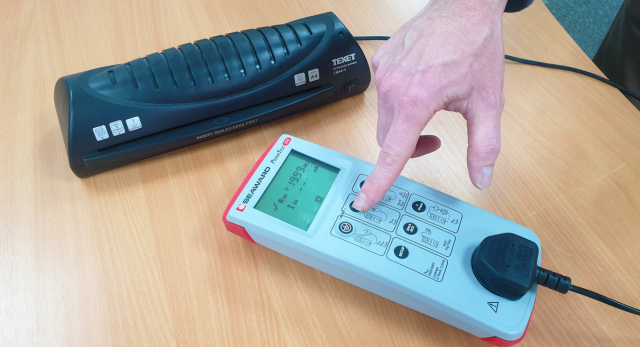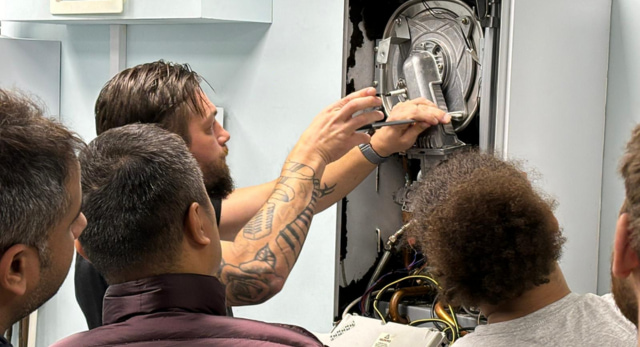Whether you’re a landlord, business owner, facilities manager, or just someone who likes their gadgets to be less “shocking,” this is your go-to guide for Portable Appliance Testing (PAT) in 2025. We’ll break down what PAT testing actually is, why it matters, who can do it, the legal stuff, and how to get trained up if you fancy adding another skill to your electrical trade.
What is PAT Testing?
PAT stands for Portable Appliance Testing. It’s the process of checking electrical appliances and equipment to make sure they’re safe to use. This isn’t just about ticking a box; it’s about preventing accidents, fires, and all the drama that comes from dodgy electrics. PAT testing involves both a visual inspection (think: “does this look like it’s about to explode?”) and a series of electronic tests using specialist equipment.
The Basics
- Portable: Anything you can move and plug in (think kettles, computers, power tools, extension leads).
- Appliance: The actual device. If it’s got a plug, it’s probably in scope.
- Testing: Visual checks and electronic tests to spot faults or hazards before they cause trouble.
PAT testing is not just for show. It’s a key part of any decent health and safety policy, especially in workplaces, rental properties, and public spaces.
Why is PAT Testing Important?
No one wants to be the reason the office Christmas party ends in a blackout (or worse, a fire drill). PAT testing is all about safety, compliance, and peace of mind.
Key Reasons to PAT Test
- Preventing Accidents: Faulty appliances are a leading cause of electrical fires and shocks.
- Legal Compliance: While not strictly a legal requirement, PAT testing helps you meet your obligations under the Electricity at Work Regulations 1989 and the Health and Safety at Work Act 1974.
- Protecting People: Keeps your staff, tenants, and customers safe.
- Reducing Downtime: Spotting faults early means less chance of equipment failure at the worst possible moment.
- Insurance: Many insurers expect evidence of regular PAT testing as part of your risk management.
The Legal Lowdown
Here’s where most people get confused: PAT testing itself isn’t a legal requirement, but keeping electrical equipment safe is. The law says you must ensure any electrical equipment that could cause injury is maintained in a safe condition. PAT testing is the industry-standard way to prove you’re doing just that.
Relevant Legislation
- Electricity at Work Regulations 1989: Employers and landlords must keep electrical equipment safe.
- Health and Safety at Work Act 1974: General duty to protect employees and the public.
- Provision and Use of Work Equipment Regulations 1998 (PUWER): Equipment must be suitable and safe for use.
- Management of Health and Safety at Work Regulations 1999: Requires risk assessments and appropriate controls.
If you’re a landlord in Scotland, PAT testing is mandatory for all rental properties, with specific requirements for frequency and record-keeping. In the rest of the UK, it’s best practice and often expected by insurers and regulators.
What Needs PAT Testing?
If it’s got a plug and you can move it, it probably needs testing. But let’s get specific.
Types of Appliances
- Class 1 (High Risk): Appliances with basic insulation and an earth connection (e.g., fridges, microwaves, toasters, desktop computers, extension leads, industrial kit).
- Class 2 (Moderate Risk): Double-insulated appliances, no earth connection (e.g., lamps, hairdryers, vacuum cleaners, drills, lawnmowers).
- Class 3 (Low Risk): Very low voltage, usually battery-powered (e.g., cameras, mobile phones, laptops, chargers, torches).
Typical Items That Need PAT Testing
- Kettles, toasters, microwaves
- Extension leads and multi-way adaptors
- Computers, monitors, printers
- Power tools and workshop equipment
- Heaters, fans, air conditioners
- Kitchen appliances in rental properties
- Anything portable and plugged in
What Doesn’t Need PAT Testing?
- Hard-wired equipment (like built-in ovens)
- Fixed wiring (that’s a job for an Electrical Installation Condition Report)
- Brand new appliances (though a quick visual check is still smart)
How Does PAT Testing Work?
PAT testing is a two-step process: visual inspection and electronic testing. Here’s how it goes down.
1. Visual Inspection
This is your first line of defence. A competent person checks for:
- Cracks, burns, or obvious damage to the appliance, cable, or plug
- Loose wires or dodgy connections
- Signs of overheating or scorching
- Missing screws or covers
- Evidence of liquid damage
Don’t forget to check the environment for daisy-chaining of extension leads or cables left where people can trip over them.
2. Electronic Tests
If the appliance passes the visual check, it’s time for the fun bit: plugging it into a PAT tester.
Common PAT Tests
- Earth Continuity Test: Checks the earth connection (Class 1 only)
- Insulation Resistance Test: Makes sure the insulation isn’t breaking down (Class 1 and 2)
- Leakage Current Test: Detects any current leaking to earth (Class 1 and 2)
- Polarity Check: Ensures live and neutral wires aren’t swapped
- Functional Test: Confirms the appliance actually works as intended
- Portable RCD Testing: For plug-in RCDs, checks they trip at the right current
You’ll get a pass or fail result for each test, and any failures mean the appliance needs repair or replacement before it’s used again.
Who Can Carry Out PAT Testing?
Contrary to popular belief, you don’t have to be a fully qualified electrician to carry out PAT testing, but you do need to be “competent.” That means having the right knowledge, training, and equipment to do the job safely and interpret the results.
Who Counts as Competent?
- Someone who has completed a recognised PAT testing course (like Logic4training’s City & Guilds 2377-77 PAT Testing Course)
- A qualified electrician
- A trained in-house facilities or maintenance person
For landlords and small businesses, it’s possible to train up a staff member, provided they’re comfortable with the technical side and understand the risks. Visual checks can be done by anyone with basic training, but combined inspection and testing should be left to someone with proper credentials.
How Often Should PAT Testing Be Done?
There’s no one-size-fits-all answer. The frequency depends on the type of equipment, how it’s used, and the environment. It’s all about risk assessment.
General Guidelines
- High-risk environments (construction sites, workshops): Every 3–6 months
- Offices and low-risk environments: Annually or biannually
- Rental properties (Scotland): Annually for high-risk, every four years for larger appliances, and always before a new tenancy
- Public spaces (schools, hotels, hospitals): At least annually, or more often for frequently used items
Key Factors
- How often the equipment is used
- Who uses it (trained staff vs. the public)
- The environment (wet, dusty, or high-traffic areas need more frequent checks)
- Manufacturer recommendations
Remember: there’s no legal requirement for a set interval, but documenting your risk assessment and testing schedule is essential for compliance and insurance.
What Records Should Be Kept?
Keeping good records is not just for the clipboard brigade-it’s your proof that you’re doing things by the book.
What to Record
- Date of inspection and testing
- Appliance details (type, make, model, serial number)
- Test results (pass/fail, readings)
- Next test due date
- Name and signature of the person who carried out the test
- Any repairs or actions taken
Labelling
Each tested appliance should have a visible label showing the test date, result, and when it’s due for re-testing. In Scotland, landlords must keep records for six years and provide tenants with copies before they move in.
PAT Testing and the Law
With regulations always evolving, it’s worth staying up to date. Here’s what’s new and what’s stayed the same for 2025.
England, Wales, and Northern Ireland
- No legal requirement for PAT testing itself, but you must keep electrical equipment safe.
- PAT testing is the most recognised way to demonstrate compliance.
- Insurers and regulators expect regular testing and good records.
Scotland
- PAT testing is mandatory for all private rental properties under the Housing (Scotland) Act 2014.
- High-risk items: tested annually.
- Larger appliances: tested every four years.
- Landlords must also get an Electrical Installation Condition Report (EICR) every five years or at the start of a new tenancy.
- All records must be kept for six years and shared with tenants.
Enforcement
In Scotland, the First-tier Tribunal for Scotland (Housing and Property Chamber) enforces compliance. Elsewhere, breaches can lead to fines, invalid insurance, or prosecution if someone is injured.
How to Get Trained: PAT Testing Courses
If you want to become a PAT tester, or just want to upskill your team, a recognised training course is the way to go.
What You’ll Learn
- Electrical safety basics
- Regulations and legal requirements
- Types and classes of appliances
- How to use PAT testing equipment
- Interpreting test results
- Recording, labelling, and documentation
- Safe working practices
Want to Become a PAT Tester?
Check out our PAT Testing Training Course City & Guilds 2377 for everything you need to get started, including practical assessments, regulations, and hands-on experience.
Common PAT Testing Myths (Busted)
Let’s clear up some common misconceptions:
“PAT testing is only for big businesses.”
Nope. If you’re responsible for electrical equipment, you should be PAT testing, whether you’re a sole trader, landlord, or multinational.
“Only electricians can PAT test.”
Not true. Anyone competent and trained can do it.
“PAT testing is legally required every year.”
There’s no set legal interval. It’s about risk, not the calendar.
“Brand new equipment doesn’t need checking.”
New kit should be visually inspected before first use, but doesn’t need full PAT testing.
“If it passed last year, it’s fine now.”
Wear and tear happens. That’s why regular checks matter.
PAT Testing in Practice: Real-World Scenarios
Offices
- Annual testing for computers, kettles, fans, and extension leads.
- More frequent checks for equipment used by multiple people.
Construction Sites
- Three-monthly checks for power tools, site lighting, and extension leads.
- High-risk due to tough conditions.
Rental Properties
- In Scotland, annual checks for portable appliances, four-yearly for white goods.
- Landlords must provide tenants with test records.
Schools, Hospitals, Hotels
- Annual or biannual testing for all portable appliances.
- Extra checks for equipment in kitchens, workshops, or public areas.
How to Choose a PAT Tester or Service
If you’re outsourcing, look for:
- Qualified, experienced testers (ask for City & Guilds 2377 certification)
- Up-to-date equipment and calibration
- Clear, detailed reports and records
- Transparent pricing (no “per item” surprises)
- Good reviews and industry reputation
- Or, train your own staff with a Logic4training PAT testing course.
PAT Testing and Insurance
Many insurers expect evidence of regular PAT testing as part of your risk management. If you can’t show you’ve been proactive, you could find your claim rejected after an incident. Keep those records up to date and handy.
FAQs
Is PAT testing a legal requirement in the UK?
No, but you are legally required to keep electrical equipment safe. PAT testing is the recognised way to prove you’re doing this. In Scotland, PAT testing is mandatory for landlords.
How often should I PAT test my appliances?
It depends on the risk. High-use or high-risk environments may need testing every 3–6 months; offices and low-risk areas can be tested annually or biannually. Always base your schedule on a risk assessment.
Who can carry out PAT testing?
Anyone who is competent, trained, and understands the risks. This could be a qualified electrician or someone who has completed a recognised PAT testing course like Logic4training’s City & Guilds 2377.
What appliances need PAT testing?
Any portable appliance with a plug, such as kettles, computers, extension leads, power tools, kitchen appliances, etc. Class 1 and 2 appliances need both visual and electronic tests; Class 3 usually just a visual check.
What records do I need to keep?
Date of testing, appliance details, test results, next test due, and the tester’s details. Each appliance should have a visible label. In Scotland, landlords must keep records for six years and provide them to tenants.
Ready to get started or up your PAT testing game?
Check out our PAT Testing Training Course City & Guilds 2377 and keep your workplace safe, legal, and a little less likely to go up in smoke.
Stay safe, stay switched on, and remember: if in doubt, test it out.









